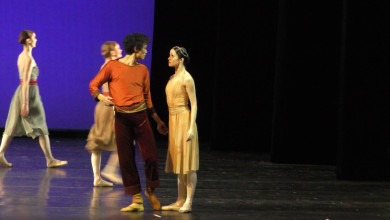Push Comes to Shove
CREDITS
Choreography by Twyla Tharp
Staged by Elaine Kudo
Music by Joseph Lamb, Franz Joseph Haydn
Costume designer: Santo Loquasto
Lighting Design by Jennifer Tipton
Recreated by Steve Shelley
ABOUT THE PRODUCTION
In the middle of 1970s, the American Ballet Theatre commissioned the ballet from Twyla Tharp for its new star, Mikhail Baryshnikov. Baryshnikov, star of classical ballets, wanted to expand his creative horizons and was interested in working with the modern dance choreographer. Tharp, who had no experience of working for grand theatres at the time, was in no hurry to agree to this flattering commission as she first wanted to make sure that the soloist that chose her could push the limits of classical dance routines. Their meeting marked the start of a long-term collaboration, which gave the world several productions and breathtaking moments of convergence between the seemingly far-away worlds of classical and popular music, of classical and modern dance. The duo of Baryshnikov and Tharp won the audiences not by stories or ideas (although somebody heard a hidden reference to the last name of Baryshnikov’s Leningrad teacher – Alexander Pushkin in the title Push Comes to Shove). The magic was born out of the combination of the choreographer’s humour and the performer’s unique blend of impeccable classical dancing skills and a disco dancer’s or Broadway jazz dancer’s swag. Now the Mariinsky Theatre soloists have the chance to challenge themselves and perform the witty choreography, which requires full body control and easiness of going from one style to the next. Olga Makarova
Premiere: 9 January 1976, American Ballet Theatre, Uris Theater, New-York
Premiere at the Mariinsky Theatre: 21 March 2019, St Petersburg
Running time 22 minutes
Production Sponsor: Toshihiko Takahashi
Age category 6+
Symphony in C
CREDITS
Music by Georges Bizet (Symphony No. 1 in C)
Choreography by George Balanchine (1947)
Staging by Colleen Neary
Costume design by Irina Press
ABOUT THE PRODUCTION
George Balanchine staged one of his most famous ballets for the company of the Opéra de Paris in 1947. Invited from beyond the ocean, the choreographer, in executing the French commission, was absolutely sure of himself: in this new work, as in most mature ballets by Balanchine, there was no plot, there were no human passions behind the dance, and only the music, its rhythm and structure determined the development of the choreographic image. The character of the dance was dictated by Georges Bizet’s youthful Symphony in C Major. Its sparkling lightness provided the name of the work – Le Palais de cristal. It is true that soon after the ballet was brought to New York the invented title became forgotten, and for over half a century many leading ballet companies throughout the world have been proud to have Balanchine’s Symphony in C in their repertoires. This ballet is ideal for showcasing a company’s merits: the four parts of the ballet are staged for four pairs of soloists, and in this ballet dancers can dazzlingly show off their skills and take on the incredibly complex fiorituri of the shading in the allegro, and proudly and majestically “sail” into the adagio.
Olga Makarova
Premiere: 28 July 1947, Théâtre National de l'Opéra, Paris
Premiere at the Mariinsky Theatre: 9 February 1996
Running time: 40 minutes
The ballet of George Balanchine Symphony in C is presented by arrangement with The George Balanchine Trust and has been produced in accordance with the Balanchine Style® and Balanchine Technique® service standards established and provided by the Trust
The Mariinsky Theatre would like to express its gratitude to Mrs Bettina von Siemens for her support in bringing the “Ballets of George Balanchine” project to life
Age category 6+
 Mariinsky Theatre:
Mariinsky Theatre:  Mariinsky-2 (New Theatre):
Mariinsky-2 (New Theatre):  Mariinsky Concert Hall:
Mariinsky Concert Hall: 

